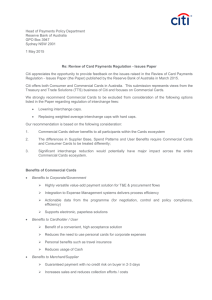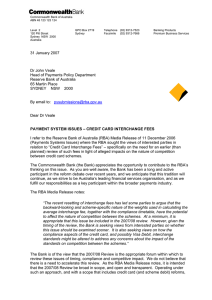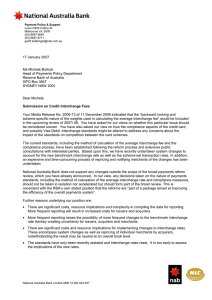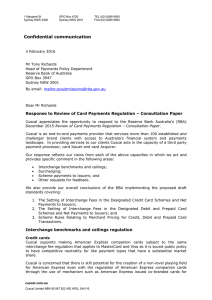Document 10842440
advertisement
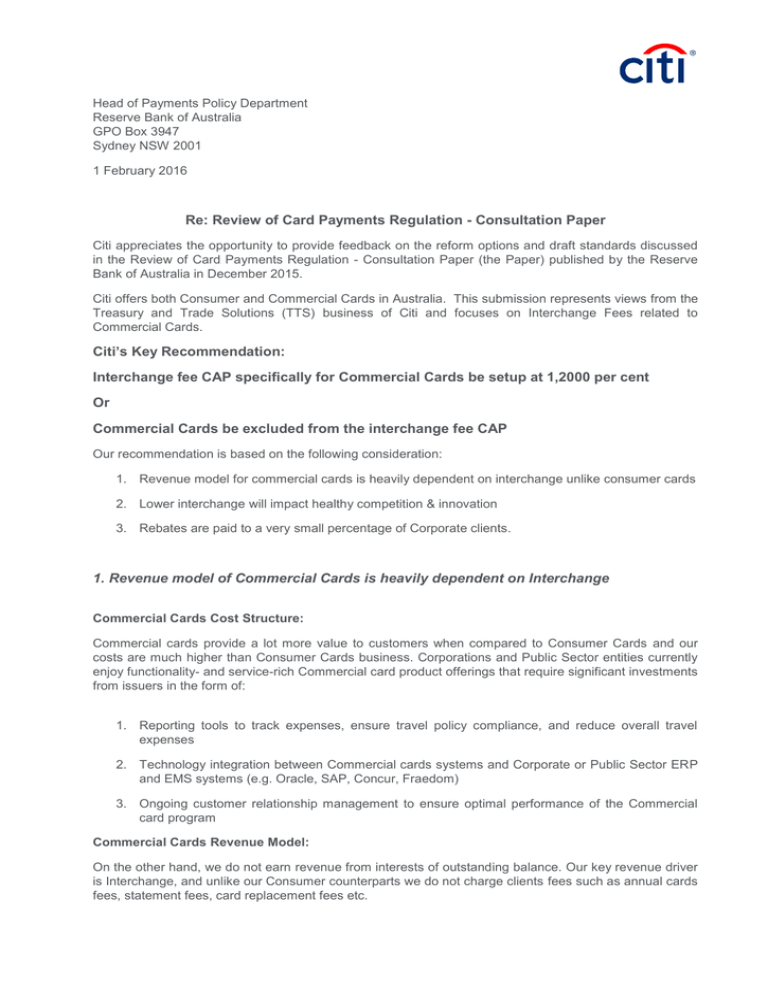
Head of Payments Policy Department Reserve Bank of Australia GPO Box 3947 Sydney NSW 2001 1 February 2016 Re: Review of Card Payments Regulation - Consultation Paper Citi appreciates the opportunity to provide feedback on the reform options and draft standards discussed in the Review of Card Payments Regulation - Consultation Paper (the Paper) published by the Reserve Bank of Australia in December 2015. Citi offers both Consumer and Commercial Cards in Australia. This submission represents views from the Treasury and Trade Solutions (TTS) business of Citi and focuses on Interchange Fees related to Commercial Cards. Citi’s Key Recommendation: Interchange fee CAP specifically for Commercial Cards be setup at 1,2000 per cent Or Commercial Cards be excluded from the interchange fee CAP Our recommendation is based on the following consideration: 1. Revenue model for commercial cards is heavily dependent on interchange unlike consumer cards 2. Lower interchange will impact healthy competition & innovation 3. Rebates are paid to a very small percentage of Corporate clients. 1. Revenue model of Commercial Cards is heavily dependent on Interchange Commercial Cards Cost Structure: Commercial cards provide a lot more value to customers when compared to Consumer Cards and our costs are much higher than Consumer Cards business. Corporations and Public Sector entities currently enjoy functionality- and service-rich Commercial card product offerings that require significant investments from issuers in the form of: 1. Reporting tools to track expenses, ensure travel policy compliance, and reduce overall travel expenses 2. Technology integration between Commercial cards systems and Corporate or Public Sector ERP and EMS systems (e.g. Oracle, SAP, Concur, Fraedom) 3. Ongoing customer relationship management to ensure optimal performance of the Commercial card program Commercial Cards Revenue Model: On the other hand, we do not earn revenue from interests of outstanding balance. Our key revenue driver is Interchange, and unlike our Consumer counterparts we do not charge clients fees such as annual cards fees, statement fees, card replacement fees etc. 2. Lower interchange will impact healthy competition & innovation If the 0.8000 per cent cap on credit card transactions were applied to Corporate Cards, it would be uneconomic (loss-making) for issuers to offer them to their customers. This will have the following impacts on the market: i. Some key current Commercial card Issuers would exit the business and would not be replaced by new entrants since the business would be loss-making. This would decrease competition contradicting one of the stated aims of the regulation which is to enhance the competition and efficiency of the payments system. ii. Create an unlevelled playing field as three-party schemes, such as for example American Express, would be handed the majority of commercial card programs, increasing their already dominant market share position because commercial cards issued by the three-party schemes are currently excluded from the maximum interchange caps. iii. Impairment to innovation due to lack of funding as a result of significant reduction of revenue income from interchange fees, which is the main revenue stream for commercial cards 3. Rebates are paid to a very small percentage of Corporate clients. We also note the consultation paper note that rebates are very common among commercial cards sector. While we acknowledge that rebates do exist for selective programs, it represents a small percentage of the commercial cards programs we support. Furthermore, as per the latest RBA data release (12 months to November 2015), the commercial credit spend represents 7.2% of the total cards spend in Australia, out of which commercial cards spend offered to large corporate represents less than 3%. Therefore to apply a separate CAP of 1.2000 per cent for commercial cards or to exclude commercial cards entirely from the CAP and lower the weighted average from 50bps to a slightly lower number, e.g. 45bps, will not have material impact to the overall objectives RBA would like to achieve through this review. In summary, Citi recommend a separate higher CAP of 1.2000 per cent for commercial cards or exclusion of commercial cards from the CAP combined with a slightly lower weighted average due to the above considerations. We look forward to the opportunity to discuss our submission with RBA. Yours sincerely, Susan Yang Head of Cards and Trade Australia and New Zealand Treasury & Trade Solutions Citi

